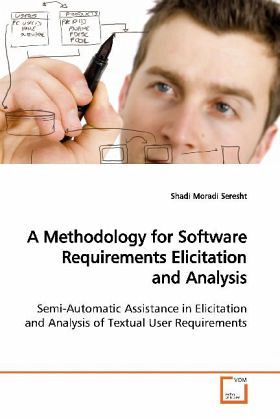
A Methodology for Software Requirements Elicitation and Analysis
Semi-Automatic Assistance in Elicitation and Analysis of Textual User Requirements
Versandkostenfrei!
Versandfertig in 6-10 Tagen
39,99 €
inkl. MwSt.

PAYBACK Punkte
20 °P sammeln!
Requirements Engineering (RE) is a sub-disciplinewithin Software Engineering increasingly recognizedas a critical component in the success of a softwaredevelopment project. With the escalating complexityof software requirements, problems of traditionalrequirements engineering techniques, including theuse of natural language text, are becomingincreasingly apparent.This research aims to assistsoftware analysts in dealing with the challenges thatexist in correctly understanding user requirementsduring the interactive process of requirementelicitation and analysis. It proposes a methodologyrelated...
Requirements Engineering (RE) is a sub-discipline
within Software Engineering increasingly recognized
as a critical component in the success of a software
development project. With the escalating complexity
of software requirements, problems of traditional
requirements engineering techniques, including the
use of natural language text, are becoming
increasingly apparent.This research aims to assist
software analysts in dealing with the challenges that
exist in correctly understanding user requirements
during the interactive process of requirement
elicitation and analysis. It proposes a methodology
related to visualization of textual requirements and
ways of making them shared, reviewed and debated by
the stakeholders. The approach is based on a
syntactic analysis and formalization of the text
written in natural language and enriched with
domain-related information extracted from reusable
domain-specific data models. The applicability of
this research is illustrated with a case study. A
prototype implementing our methodology is developed
as a proof-of-concept. The results of controlled
experiments designed to evaluate our approach prove
the validity of the methodology.
within Software Engineering increasingly recognized
as a critical component in the success of a software
development project. With the escalating complexity
of software requirements, problems of traditional
requirements engineering techniques, including the
use of natural language text, are becoming
increasingly apparent.This research aims to assist
software analysts in dealing with the challenges that
exist in correctly understanding user requirements
during the interactive process of requirement
elicitation and analysis. It proposes a methodology
related to visualization of textual requirements and
ways of making them shared, reviewed and debated by
the stakeholders. The approach is based on a
syntactic analysis and formalization of the text
written in natural language and enriched with
domain-related information extracted from reusable
domain-specific data models. The applicability of
this research is illustrated with a case study. A
prototype implementing our methodology is developed
as a proof-of-concept. The results of controlled
experiments designed to evaluate our approach prove
the validity of the methodology.












